Article about the importance of the hands power in the rockclimbing
The translation of the Eva Lopes article about importance of developing the hands power in rockclimbing. Comments by rockclimbing coach of the MCS AlexClimb rockclimbing School - Alex Kozhevnikov!
Only automatically translated version is available at the moment, sorry for the inconvenience.
The strength of the hand in climbing.
Although all those involved in climbing, it is clear that the strength of the hands is not the most important in climbing, but it does not mean that it is not necessary to develop and maintain, as well as, it does not mean that doing a certain kind of climbing you do not turn into in rukastogo-paltsastogo mutant. Often climbing information sources exaggerate or give examples to illustrate this postulate is doubtful. Adam Ondra and Dave Graham - two modern climbers, known for his incredible achievements, however, mentioned that neither of them can not catch up on one arm.

This fact has been misinterpreted as the fact that they simply have weak hands, though, if we talk about the power of hands, in a certain aspect, they have no equal in the world! Two hands, they can perform an incredibly large number of pull-ups, can effortlessly be in blocks indefinitely. At the same time, having a peak strength to pull himself up on one arm - at the same time having enough strength and endurance in the hands, in order to successfully get out climbing the most difficult routes and boulders.
AK .:
Do not confuse strength and endurance. A large number of pull-ups - this endurance ie the ability for some time to support the work of a certain power long enough...
In this article, we will try to explain and to give a definition of what is arm strength in climbing. In addition, we will talk about the many other concepts that can positively affect the quality of your workouts and give way to boost the effectiveness of exercise, and as a result, provide motivation and help you achieve the results that you are aiming at climbing.
But first, we need to give the definition of several concepts can be a bit boring, but it is absolutely necessary to understand what is written on. Do not forget that the text refers specifically to the power of hands at rock climbing, here we are not concerned with the theme of finger force - is a different story, which we will consider separately.
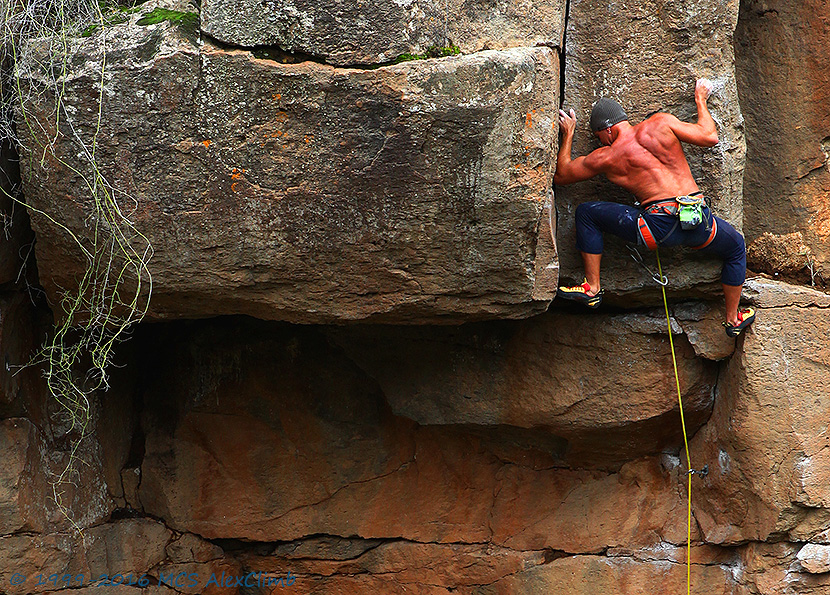
AK .:
It seems to me that the term "power source" is too general. Hands consist of a large number of muscles. In addition, the same pulling up notorious is important biceps and back. Main is the weak link climber - the muscles, which are located in the forearm. They will just "hammered" Therefore, it may actually have a situation where a person can not catch up with a large load - force "pulling" muscles are not very big, but the underlying muscles of the forearm can be at the same time strong and hardy. So what is "the power of arms," I do not really understand.
The strength, or its ability to develop, apply to certain methods for muscle contraction, which are directly related to the effects of tension between muscle tissue and ligaments.
AK .:
Strictly speaking, the strength of a particular muscle is dependent on a number of factors. For example, muscle composition. Muscles containing a large number of m. N. glycolytic muscle fibers, other things being equal, will be able to develop more force than muscle, which mainly contains the oxidative muscle fibers. However, the latter will be more durable. Just force depends directly proportional to the number of muscle fibers (practically trained by value) and their size (largely determines the amount of myofibrils, and this is just the trainee parameter). In addition, the maximum force is largely dependent on the intensity of activation of motor neurons of the spinal cord of the muscle pool.

This ability is not synonymous with movement, such as, if you hang in the 45-degree block on the bar, neither sinking nor rising, and without moving any part of the body - in this case no one can deny that in this exercise, arm strength is used in full .
Several classical definitions of strength:
• The concept of power can be defined as the ability of the muscles to resist stress load. This ability depends entirely on the ability to reduce muscle tissue. (Moreous. The physiology of exercise).
• Strength - is the ability of a muscle or muscle group at a certain speed to develop the voltage from zero to maximum. In other words, the strength - the ability to contract the muscles during a certain period of time. (Goldspink, 1992). Excellent definition, but they help in practice?
I asked questions - how is it possible that Dave Graham effortlessly squeezes routes that require a huge force of hands? Or - why, if you can lift with one hand over his head 32 pound dumbbell, but at the same time on the climbing route 30 meters long and completely exhausting yourself without forces already in the middle of the route ?! Or - why climber, which can be tightened on the bar 40-50 times, thus can not catch up on the one hand and barely keeps itself in the block?
Regarding the concept of force is important to understand that muscle contraction is not necessarily connected with the movement of any part of our body.
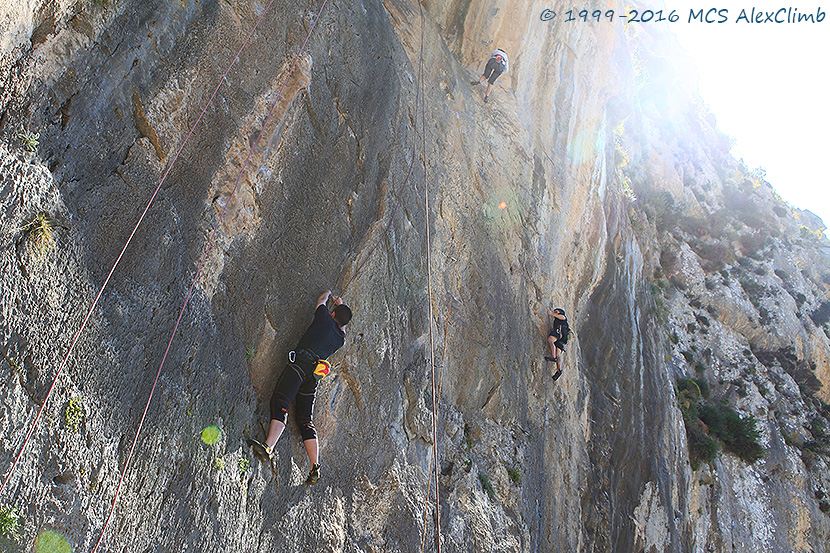
The climbing is particularly noticeable since the passage of the climbing route, we encounter a succession of static body positions and locks. And, as is known to the majority of climbers, these blocks and tense body posture - this is just the very thing that can cause a complete loss of power and, as a consequence - failure on the route. But how to increase muscle strength, which does not move? Let us again define some concepts that will be needed to understand the process, increase strength, and for the correct formation of the training process. Let us remember that the strength of muscle contraction and are always associated with the effect of tension inside the muscle, the muscle at the same time can be shortened, extended, can be in motion or no motion, to be in static load phase.

isotonic contraction
A good example of an isotonic load will perform a pull-out position fully extended arms, to the position of maximum bent. Another similar example - if you start with a fully folded hands, and finish the exercise completely hanging on the crossbar - in both cases it will be two visa isotonic load - the kind of muscle activity when the muscle is contracting, changes its length, as in the case of the above example about pulling up. There are two types of isotonic load:
The concentric isotonic contraction is when the muscle develops tension shortening up to a limit (pulling). This is the most common form of physiological stress. Eccentric isotonic contraction, in this case, is also developing muscle tension, but not reduced, and the extension to the limit. This process is not necessarily related to the inability to retain muscle in a shortened state - as the lengthening of the muscles can be justified and controlled process (gradual lowering of the body when pulling down). Eccentric muscle contraction is most help develop strength and at the same time it spends more. And the other side of the coin - the muscle remains still tense - either lengthened or shortened - in this case we speak of isometric contraction.
Isometric contraction - muscle tense continuously without shortening or lengthening, is in a constant state of static electricity. A good example - still hovering at the bar in 45-degree block. In this case, neither rising nor falling, you can make a very significant load on the muscles of the arms - this exercise requires the more "power", the more time you are in this position.
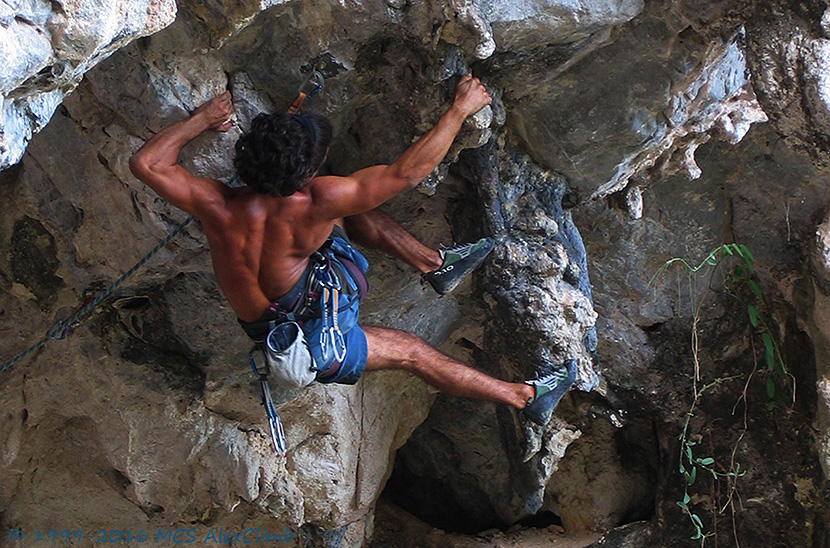
AK .:
Blocks of 45 degrees, and so on. D. Are not binding. When lyubyhstaticheskih wyssachen loads and working out muscle on isometric mode.
In all three types of climbing loads vary, but it should be noted that this form of isometric exercise found climbing much more frequently than in other sports. There are special exercises, which combine all three types of load, in this case we are talking about auksotonicheskih (?? How is it at the Russian say ?! - approx interpreter.) Reductions.
Auksotonicheskie reduction.
A clear example auksotonicheskoy load will perform pull-ups on the bar, to the highest phase of the exercise (isotonic concentric contraction of the muscles) and fix it for a few seconds in the block (isometric contraction), then slowly lower to the starting position (isotonic eccentric contraction of the muscles). Auksotonicheskaya load - this is the case when the isotonic contraction combined with isometric contractions, and, amplified to a greater extent in the early phase of isotonic exercises, and in the end - isometric. Try to understand these concepts in practice, during training, perhaps this information will help to more accurately understand the processes that occur in your body.
AK .:
Speaking terminology very strictly, in real conditions isotonic mode (voltage equally - changing muscle length) does not occur because there is always a resistance, the voltage changes. In the real world there is just auksotonichesky operation muscles (and the length and voltage changes).
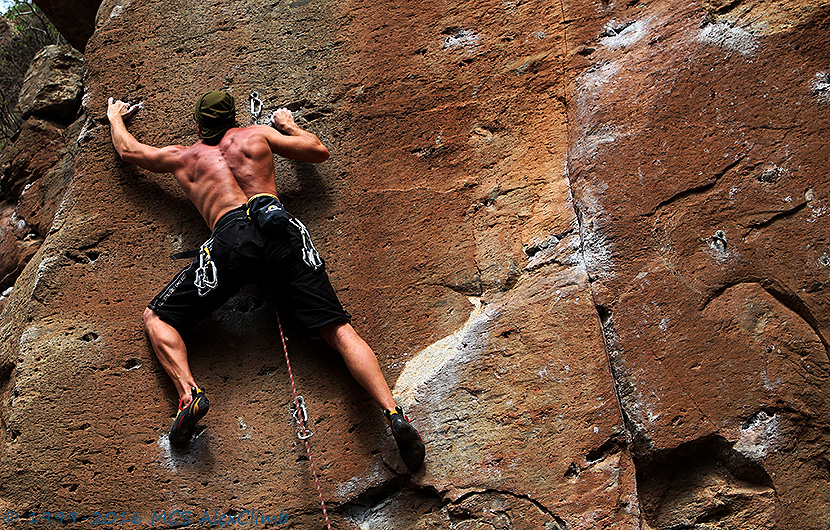
It is important to mention that the muscle operation as "plyometric". This mode is characterized by a rapid succession of eccentric and concentric modes. For example, the repulsion up after jumping off the dais. Used for maximum workout and explosive power. Exercise "double dynamics" - a classic example of a plyometric mode muscles.
In climbing, in addition to the techniques and tactics, especially in the heavily overhanging routes and bouldering, arm strength - this is quite a serious advantage. It is understood that 20 interceptions on small hooks with a good support for the feet, it is not the same thing as 5 interceptions in blocks without footrests - in these cases require different qualities - endurance in the first example and the total (explosive) strength in the second . In the continuation of the article, we will continue to give definitions by which you may already be tired, but without them it will not work to understand the details of how to develop exactly those qualities that are lacking for the solution of certain problems of sport.
As already mentioned, the strength - the ability to develop resistance to the load voltage, with the load - is broadly variable factor that may alter the limits of this power.
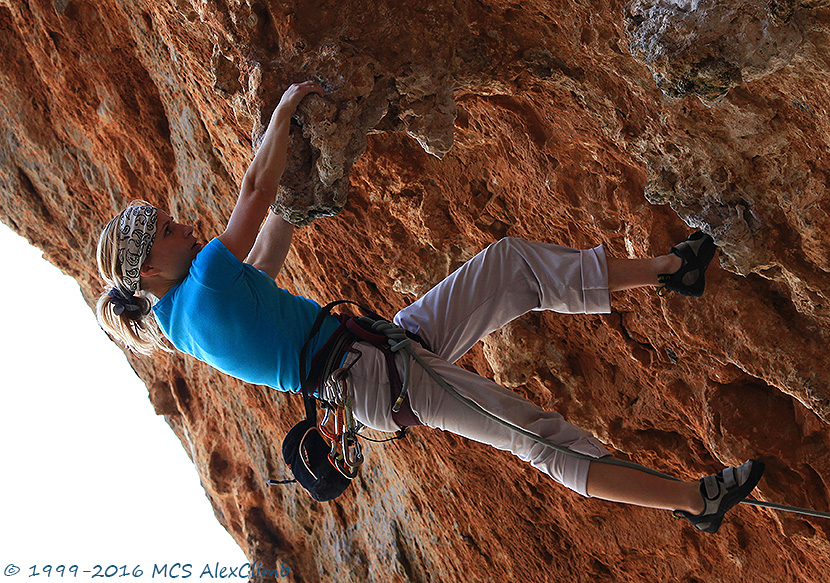
20 pull-ups can take away your power with the same success as the 5 with a load hanging from a belt, but the biological systems that are involved in the process - will be different. There is a very important concept, which is that any exercise involving untrained muscle group will lead to an increase in strength in it. If you decide to start jogging - the muscles of your legs become stronger. It is clear that, although, in this case, we are dealing with aerobic exercise, but be that as it may, any exercise aimed at developing the untrained muscles always lead to an increase in muscle tissue and the metabolism of the restructuring to protect the body at the time of application of the load, while The maximum power will increase proportionally.
AK .:
The statement that "any exercise involving untrained muscle group will lead to an increase in power it" is only partially true.
It should be understood that "any" exercise may not significantly alter the muscle. To muscles changed (getting stronger or fitter) need special exercises, more precisely, the special conditions. For example, for the development of makismalnaya forces used the maximum weight (or very little hooks). You also need proper nutrition.
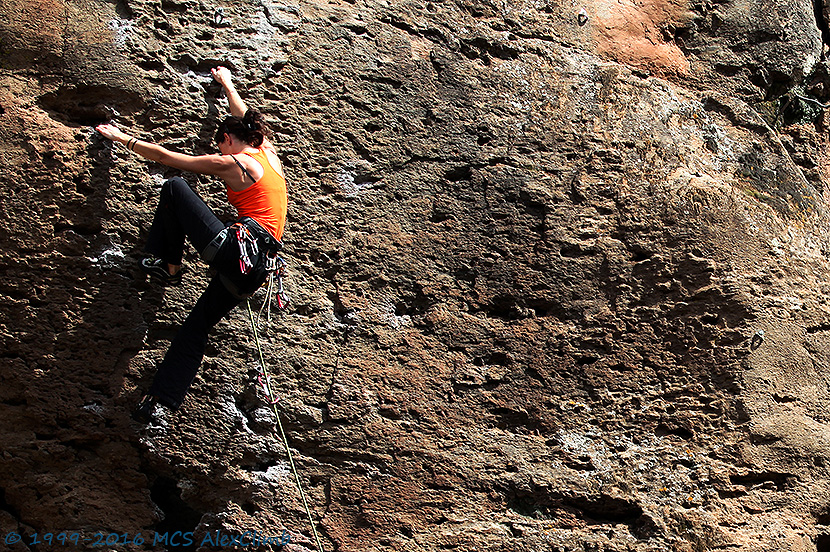
Indeed, if forced to work a muscle or muscle group that has not worked, it will force it to grow. But only slightly. Imagine that you were in the hospital for a long time and many muscles "weak." You left the hospital and started to walk, exercise. Of course, after some time, the functional state of the muscles had improved infrastructure. But only up to a certain limit. Then the increase in strength is possible only by special uprazheniniyami that must be made in certain circumstances. The number of approaches, the amount of load, rest time, number of repetitions - all this will be very important.
Thus, no matter what kind of exercise you perform, the result is an increase in strength.
AK .:
This assertion is fundamentally not true. You can pick up uprazheniya, the result of which will increase endurance. In this example, the maximum power can even be reduced.
But we must understand that certain exercises develop and support a variety of biological processes, and training on the proper construction of the system depends on the effectiveness of these exercises for the development of the necessary qualities. You have to understand what kind of effect you want to develop and build the training system accordingly:

According to the classics, exercises for the development of maximum strength are performed with a maximum weight, in our case with the hands - is the weight with which you can catch up once. Maximum power is defined as the force that a person can develop a single maximum muscle force. But it is also necessary to bear in mind that this effort must be controlled and can be isometric. We can say that the maximum force in an isometric form is always greater than that which the muscle can develop in an isotonic form of load. However, it is not necessary that only the possession of maximum physical strength will allow you to win bouldering competitions. At the beginning of this article, we cited the example of two well-known climbers who do not possess supernatural physical strength, but famous for their successful ascent of the hardest climbing routes in the world.
Explosive strength
Explosive strength is the ability of the neuro-muscular apparatus to develop the stress associated with a high rate of contraction of muscle fibers. Neuro-muscular system responds to the explosive nature of the load, by precise coordination of the moment voltage of one group of muscles and a simultaneous sharp relaxation of others. A good example of the use of explosive power - a different dynamic movement in bouldering, to perform which do not necessarily have the ability to catch up on one arm, but you need to have a good explosive power of both hands, to carry out an accurate and powerful jerk.
Segment is important to mention the so-called "elastic" that somehow involved in the use of "explosive force". "Elasticity" - the most appropriate term in order to avoid confusion between the "reduce speed" and the concepts of "power cuts".

This mechanism applies to both actions, they are the components of its complex coordination and reflexes, in particular, which is defined as a special area of application effort. Another example - a sharp dynamic motion in the direction of the remote hooks, does not start from zero, but with pre-swing in the opposite direction, in order to add the motion additional amplitude - This example illustrates the concept of "elasticity" as a third factor which is neither the force or the speed of muscle contraction. It is this "elasticity" is the key to effective use of explosive force.
AK .:
Maximum strength and explosive power are very important for bouldering.
These two aspects of strength training are heavily dependent on the ability of the neuromuscular system to include all the muscle fibers at the same time and in a short time. Strictly speaking, one can imagine two soverschenno same muscles, but one will develop one maximum force, and the other - the other. And the whole thing is in my head :-) special training necessary to "teach the brain" to connect all the muscle fibers at once.
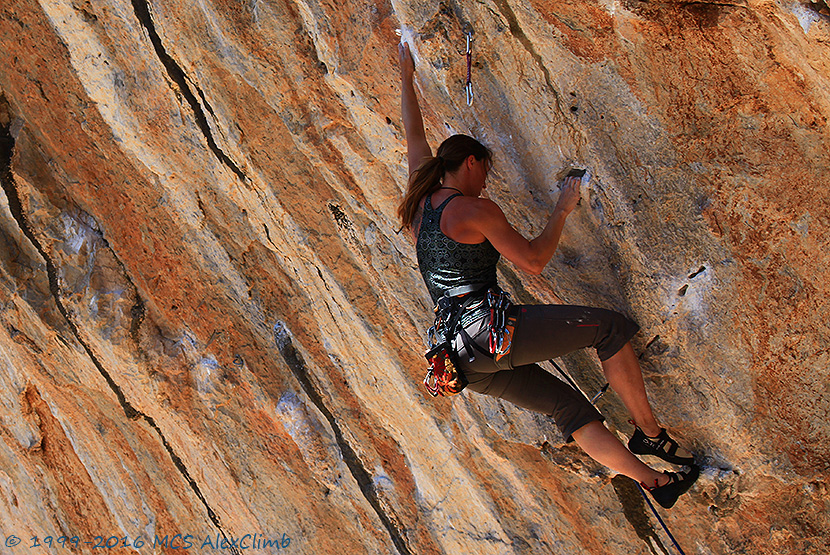
In the literature, there is evidence that an untrained person at the moment of maximum force using only 50% of its capacity. This is simply because the brain is not able to include all that is.
Strength endurance
Strength endurance - is the ability of your body to endure physical fatigue. Its characteristic is the ability, exerting considerable force, while at the same time to keep it. How many times you will be able to catch up to the moment, however no longer be able once? - This is the limit of power endurance. It is a fact that the development and training of maximum strength as a positive effect on strength endurance, but not necessarily vice versa.






